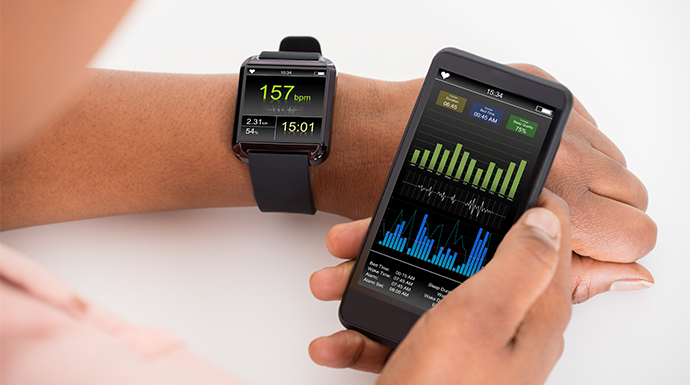SPONSOR: CardioComm Solutions (EKG: TSX-V) – The heartbeat of cardiovascular medicine and telemedicine. Patented systems enable medical professionals, patients, and other healthcare professionals, clinics, hospitals and call centres to access and manage patient information in a secure and reliable environment.

———————-
Wearable Devices Useful for Predicting Patient Health Outcomes
Wearable devices and accelerometers can be used to estimate health status and death risks in older patients more accurately than other methods used by physicians, experts say.

Source: Thinkstock
October 30, 2019 – Wearable devices and accelerometers worn like a watch, belt, or bracelet to track movement are a more reliable measure of physical activity and better for assessing five-year risk of death in older adults than more traditional methods, according to a new study by Johns Hopkins Medicine. Researchers say that an objective accounting of physical activity outperforms traditional predictors of mortality within five years, such as age, smoking, diabetes, alcohol use, or history of cancer or heart disease.
“We’ve been interested in studying physical activity and how accumulating it in spurts throughout the day could predict mortality because activity is a factor that can be changed, unlike age or genetics,†says Ciprian Crainicanu, PhD, professor of biostatistics at the Johns Hopkins Bloomberg School of Public Health, who is also a member of the research team.
Using data from the National Health and Nutrition Examination Survey (NHANES) conducted by the Centers for Disease Control and Prevention (CDC), researchers looked at 33 predictors of five-year all-cause mortality, including 30 objective measures of physical activity, such as total activity, amount of time not moving, or amount of time doing moderate to vigorous activity.
“People can overestimate on surveys how much and when they move, but wearable devices provide accurate data that cuts through bias and guesswork,†explained Jacek Urbanek, PhD, assistant professor of medicine at Johns Hopkins Medicine and a member of the research team.
All 3,000 adult participants between 50 and 85 years old wore an accelerometer device at the hip for seven consecutive days to track physical activity. Individual data came from responses to demographic, socioeconomic, and health-related survey questions, along with information accessed from medical records and clinical laboratory test results.
With a focus on fragmented activity, researchers also collected data for two-hour spans throughout the day, and their analysis showed that physical activity, or lack thereof, between noon and two in the afternoon was the highest predictor of mortality risk.
“The most surprising finding was that a simple summary of measures of activity derived from a hip-worn accelerometer over a week outperformed well-established mortality risk factors such as age, cancer, diabetes and smoking,†says Ekaterina Smirnova, MS, PhD, assistant professor of biostatistics at Virginia Commonwealth University and the lead author on the paper.
While gender proportion was even, men made up 51 percent, and 65 percent of the men died within five years of the study’s follow up efforts.
When comparing the data of those who died within five years and those who survived, researchers said they were able to correctly rank the mortality risk using accelerometers 30 percent more accurately than using information about smoking status, and 40 percent better than using information about whether a person suffered a stroke or had cancer.
As a result, physicians feel confident that these devices could be used as fitness profiles to help patients change unhealthy behaviors, increase physical activity, and potentially extend healthy lifespan. However, using wearable technology it does not guarantee that one’s risk of mortality is going to be lower with more physical activity.
Consumer-grade mHealth wearables are finally beginning to make their mark in remote patient monitoring programs.
For example, the extremely popular and user-friendly Fitbit tracker can be used in some RPM programs and also used to identify trends that call for clinical intervention.
A study done by the researchers at Cedars-Sinai Medical Center and UCLA in May of 2018 recruited 200 patients with ischemic heart disease (IHD) and had them wear Fitbit Charge 2 trackers for 90 days.
The average number of steps recorded per day correlated with the patient’s self-reported overall health, physical function, fatigue, and the results that the study found. The findings suggested relationships between physical activity and health, as well as physical function.
“Our study used a single device with high unity, which simplifies the task of remote monitoring for both researchers and patients,†the researchers reported. “The ability of the device to simultaneously record multiple variables such as heart rate and accelerometer data, also allowed us to more accurately determine the patient’s state, whether he/she is active, sedentary, asleep, or not currently using the device.â€
Because researchers were able to easily access activity data, clinicians monitoring these patients through their Fitbits can get a real-time glimpse of their health and physical function, enough to spot dangerous trends and intervene.
Wearables to track patient health has a significant correlation, according to the evidence found in recent research.
“An accurate measure of physical activity is a more reliable way for doctors and patients to assess physical activity and intervene to increase it as a potential way to improve health,†noted Andrew Leroux, a PhD candidate at Johns Hopkins and co-author of the study report.
Source: https://mhealthintelligence.com/news/wearable-devices-useful-for-predicting-patient-health-outcomes